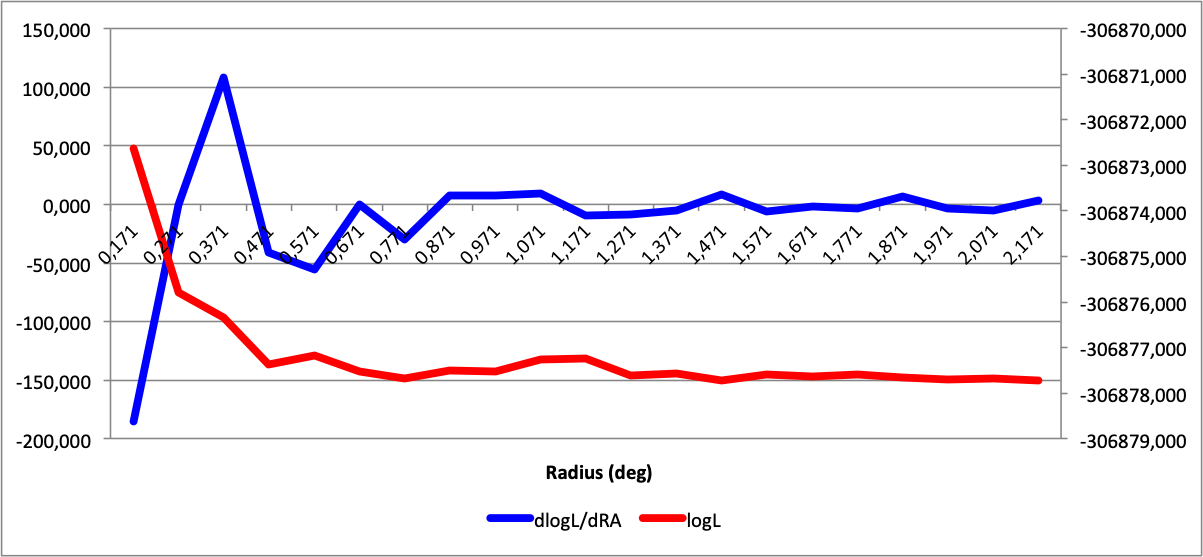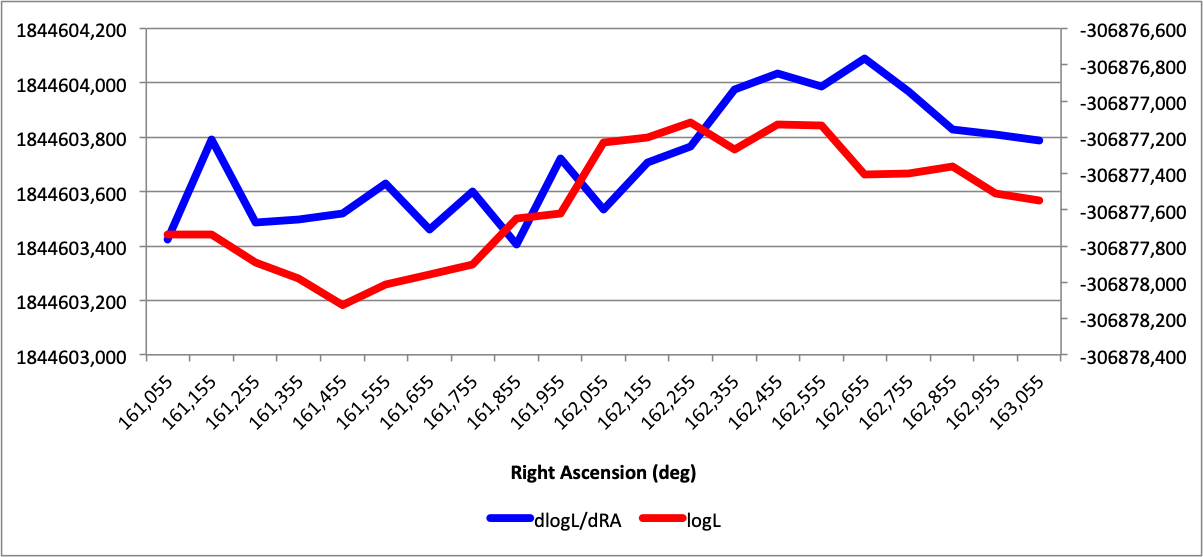Bug #3889
Fix COMPTEL response computation for extended models
| Status: | Closed | Start date: | 10/27/2021 | |
|---|---|---|---|---|
| Priority: | Normal | Due date: | ||
| Assigned To: | % Done: | 100% | ||
| Category: | - | |||
| Target version: | 2.0.0 | |||
| Duration: |
Description
Following the analysis described on https://cta-redmine.irap.omp.eu/projects/comptel/wiki/Carina_analysis there are some issues with the convergence for radial disk models. It appears that for small initial disk radii the initial parameter values are little changed, while for larger radii they change. This issue also follows up on #2973.
Recurrence
No recurrence.
History
#1
 Updated by Knödlseder Jürgen over 3 years ago
Updated by Knödlseder Jürgen over 3 years ago
- File test_likelihood_profile_RA.png added
- Status changed from New to In Progress
- % Done changed from 0 to 10
I made some likelihood profiles for the 11 bin Eta Carinae analysis (see https://cta-redmine.irap.omp.eu/projects/comptel/wiki/Carina_analysis) and they clearly show that there is a noise problem with the likelihood profiles that obviously prevents convergence of the maximum likelihood optimiser. Consequently, the algorithm used for the radial model computation should be reinvestigated.
 |
 |
#2
 Updated by Knödlseder Jürgen over 3 years ago
Updated by Knödlseder Jürgen over 3 years ago
- File test_likelihood_profile_Radius.png added
#3
 Updated by Knödlseder Jürgen over 3 years ago
Updated by Knödlseder Jürgen over 3 years ago
- File likelihood-profile-new.png added
- % Done changed from 10 to 50
I implemented the extended model response convolution in the system of the model, which is similar to the method that is implemented for CTA. This stabilised the model fit and led to smooth likelihood profiles, as illustrated below

#4
 Updated by Knödlseder Jürgen over 3 years ago
Updated by Knödlseder Jürgen over 3 years ago
I redid the fitting of the Crab using the new implementation. I used an initial extension of 0.1° for the tests. Initially I implemented a common extended method for radial and elliptical models, yet I switched the to a specific radial method for speed reasons.
| Implementation | logL | TS | RA | Dec | Extension | Prefactor (1e-5) | Index | CPU (sec) |
| Old | -67047.046 | 1081.959 | 83.78 ± 0.12 | 21.66 ± 0.11 | 1.10 ± 0.45 | 178.83 ± 9.29 | -2.147 ± 0.037 | ? |
| New (extended) | -67044.586 | 1076.430 | 83.79 ± 0.12 | 21.66 ± 0.11 | 1.15 ± 0.43 | 178.55 ± 9.28 | -2.149 ± 0.037 | 1513.17 |
| New (radial) | -67044.586 | 1076.430 | 83.79 ± 0.12 | 21.66 ± 0.11 | 1.15 ± 0.43 | 178.55 ± 9.28 | -2.149 ± 0.037 | 1209.85 |
#5
 Updated by Knödlseder Jürgen over 3 years ago
Updated by Knödlseder Jürgen over 3 years ago
- % Done changed from 50 to 60
Here the results with the final code as function of initial radial disk model extent:
| Initial extent | logL | TS | RA | Dec | Extension | Prefactor (1e-5) | Index | CPU (sec) |
| 0.1 | -67044.586 | 1076.430 | 83.79 ± 0.12 | 21.66 ± 0.11 | 1.15 ± 0.43 | 178.55 ± 9.28 | -2.149 ± 0.037 | 1209.85 |
| 1.0 | -67044.610 | 1081.130 | 83.79 ± 0.12 | 21.66 ± 0.11 | 1.18 ± 0.42 | 179.14 ± 9.29 | -2.149 ± 0.037 | 1116.22 |
| 5.0 | -67044.477 | 1069.184 | 83.79 ± 0.12 | 21.66 ± 0.11 | 1.13 ± 0.44 | 177.13 ± 9.25 | -2.146 ± 0.037 | 1137.58 |
While the fit results are very close, yet not identical, there is a significant difference in the TS values of the results.
#6
 Updated by Knödlseder Jürgen over 3 years ago
Updated by Knödlseder Jürgen over 3 years ago
I redid the same analysis using navgr=3 and nincl=13:
| Initial extent | logL | TS | RA | Dec | Extension | Prefactor (1e-5) | Index | CPU (sec) |
| 0.1 | -67574.643 | 1105.155 | 83.812 ± 0.12 | 21.63 ± 0.11 | 1.24 ± 0.40 | 184.91 ± 9.39 | -2.167 ± 0.037 | 833.48 |
| 1.0 | -67574.715 | 1107.232 | 83.811 ± 0.12 | 21.63 ± 0.11 | 1.23 ± 0.41 | 185.07 ± 9.39 | -2.168 ± 0.037 | 801.59 |
| 5.0 | -67574.782 | 1109.803 | 83.811 ± 0.12 | 21.63 ± 0.11 | 1.23 ± 0.40 | 185.51 ± 9.40 | -2.169 ± 0.037 | 1063.94 |
This reduced the variation of the TS value and also stabilised the final source extension. I also did an analysis using navgr=3 and nincl=5 to investigate whether the change to navgr=3 can explain the stabilisation:
| Initial extent | logL | TS | RA | Dec | Extension | Prefactor (1e-5) | Index | CPU (sec) |
| 0.1 | -70446.727 | 988.203 | 83.77 ± 0.12 | 21.67 ± 0.11 | 0.71 ± 0.67 | 172.94 ± 9.19 | -2.187 ± 0.039 | 1863.39 |
| 1.0 | -70446.725 | 990.848 | 83.77 ± 0.12 | 21.67 ± 0.11 | 0.69 ± 0.69 | 173.24 ± 9.18 | -2.188 ± 0.039 | 1807.3 |
| 5.0 | -70446.724 | 978.498 | 83.77 ± 0.12 | 21.67 ± 0.11 | 0.68 ± 0.70 | 171.71 ± 9.16 | -2.185 ± 0.039 | 2041.49 |
There is still some variability in TS, hence the stabilisation seems more to come from the change to nincl=13. Interestingly, the extension is smaller for navgr=3 compared to navgr=5 which calls for some parametric exploration. This was all done with an initial extent of 5.0 to be off the best-fitting values.
| navgr | nincl | logL | TS | RA | Dec | Extension | Prefactor (1e-5) | Index | CPU (sec) |
| 3 | 5 | -70446.724 | 978.498 | 83.77 ± 0.12 | 21.67 ± 0.11 | 0.68 ± 0.70 | 171.71 ± 9.16 | -2.185 ± 0.039 | 2041.49 |
| 3 | 7 | -69267.790 | 1067.124 | 83.83 ± 0.12 | 21.66 ± 0.11 | 1.04 ± 0.48 | 184.90 ± 9.43 | -2.199 ± 0.038 | 1295.11 |
| 3 | 9 | -68458.036 | 1117.489 | 83.85 ± 0.12 | 21.65 ± 0.11 | 1.20 ± 0.41 | 188.26 ± 9.45 | -2.185 ± 0.037 | 1076.23 |
| 3 | 11 | -67924.532 | 1120.166 | 83.83 ± 0.12 | 21.63 ± 0.10 | 1.22 ± 0.41 | 186.44 ± 9.40 | -2.171 ± 0.037 | 1072.88 |
| 3 | 13 | -67574.782 | 1109.803 | 83.81 ± 0.12 | 21.63 ± 0.11 | 1.23 ± 0.40 | 185.51 ± 9.40 | -2.169 ± 0.037 | 1063.94 |
| 3 | 15 | -67259.101 | 1121.117 | 83.80 ± 0.12 | 21.61 ± 0.11 | 1.27 ± 0.39 | 187.92 ± 9.44 | -2.175 ± 0.037 | 872.02 |
| 3 | 17 | -67002.840 | 1120.663 | 83.79 ± 0.12 | 21.61 ± 0.11 | 1.22 ± 0.41 | 186.94 ± 9.41 | -2.171 ± 0.037 | 831.56 |
| 3 | 19 | -66850.621 | 1120.838 | 83.77 ± 0.12 | 21.61 ± 0.11 | 1.22 ± 0.41 | 187.78 ± 9.44 | -2.175 ± 0.037 | 937.08 |
| 5 | 5 | -67044.477 | 1069.184 | 83.79 ± 0.12 | 21.66 ± 0.11 | 1.13 ± 0.44 | 177.13 ± 9.25 | -2.146 ± 0.037 | 1137.58 |
| 5 | 7 | -66664.677 | 1112.682 | 83.82 ± 0.12 | 21.65 ± 0.11 | 1.25 ± 0.40 | 186.69 ± 9.45 | -2.171 ± 0.037 | 1039.57 |
| 5 | 9 | -66391.486 | 1120.405 | 83.84 ± 0.12 | 21.64 ± 0.10 | 1.23 ± 0.40 | 188.29 ± 9.48 | -2.177 ± 0.037 | 1083.66 |
| 5 | 11 | -66185.036 | 1123.623 | 83.82 ± 0.12 | 21.63 ± 0.10 | 1.24 ± 0.40 | 187.18 ± 9.44 | -2.169 ± 0.037 | 1083.93 |
#7
 Updated by Knödlseder Jürgen over 3 years ago
Updated by Knödlseder Jürgen over 3 years ago
- % Done changed from 60 to 70
I now analysed the Crab data for different spatial models to check if they give consistent results. I switched back to navgr=5 and nincl=5 for this analysis. I used the default value for the initial extent.
| Model | logL | TS | RA | Dec | Extension | Prefactor (1e-5) | Index | CPU (sec) |
| Point source | -67045.600 | 1004.167 | 83.79 ± 0.11 | 21.63 ± 0.10 | 167.64 ± 8.56 | -2.149 ± 0.038 | ? | |
| Disk | -67044.610 | 1081.130 | 83.79 ± 0.12 | 21.66 ± 0.11 | 1.18 ± 0.42 | 179.14 ± 9.29 | -2.149 ± 0.037 | 1116.22 |
| Gauss | -67044.718 | 1100.844 | 83.79 ± 0.12 | 21.65 ± 0.11 | 0.62 ± 0.21 | 181.32 ± 9.37 | -2.150 ± 0.037 | 1118.39 |
| Elliptical disk | -67043.742 | 1027.716 | 83.78 ± 0.12 | 21.69 ± 0.10 | 90*, 1.23 ± 0.11, 0.46 ± 46287.68 | 178.49 ± 18014520.40 | -2.151 ± 0.038 | 8225.75 |
| Elliptical Gauss | -67045.211 | 1127.502 | 83.78 ± 0.11 | 21.65 ± 0.11 | 145.09 ± 15.99, 1.14 ± 0.74, 0.31 ± 0.77 | 196.44 ± 75.87 | -2.132 ± 0.035 | 4212.23 |
*Fitting the elliptical disk model gave the notification Parameter "PA" has zero curvature. Fix parameter. and consequently the position angle was not fitted. This all led to large errors for the semi-minor axis value and the flux. Maybe the model extension was too small to give a non-zero gradient.
#8
 Updated by Knödlseder Jürgen almost 3 years ago
Updated by Knödlseder Jürgen almost 3 years ago
- Status changed from In Progress to Closed
- % Done changed from 70 to 100
The response computation seems to work now, close the issue.


